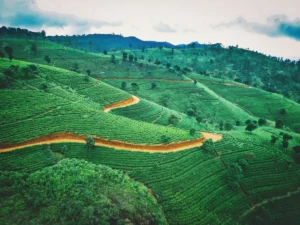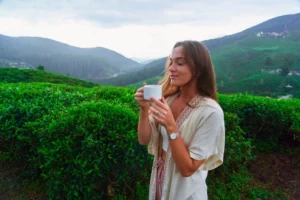Hiking the Sri Lanka Pekoe Trail
If you’re planning your next big hiking adventure in South Asia, or more specifically the Indian subcontinent, the Sri Lanka’s Pekoe Trail should be at the top of your list, easily. Officially opened for tourists in late 2023, this scenic long-distance trail winds through the heart of the island’s famed tea country, offering hikers a chance to experience both natural beauty and cultural heritage. Because of the uniqueness of this hike this hike has been highlighted as best of the world 20 places in National Geographic ranks.
With 2025 shaping up to be one of the best recent years for travel to Sri Lanka (according to the Sri Lanka Tourism Development Authority), now is definitely the time to start planning as a beginner. Here’s everything you need to know to prepare for hiking the Sri Lanka Pekoe Trail in 2025.

What is the Pekoe Trail?
First thing’s first. The Pekoe Trail is a 300-kilometer long-distance hiking route that spans 22 stages, starting in Kandy and ending in Nuwara Eliya, with segments passing through Ella, Hatton, and Haputale. Designed to take you deep into Sri Lanka’s hill country, the trail weaves through lush tea plantations, misty forests, rural towns and remote villages. Developed as part of a sustainable tourism initiative, it’s ideal for those seeking an immersive experience in one of Asia’s most scenic regions. Some people even say that the Ella Train Ride is the most scenic train ride in the world. Well, you can be the judge of that.
1. Best Time to Hike the Pekoe Trail
The best months for hiking the Pekoe Trail are January to March and June to September, when the weather is generally cooler and drier. Avoid the monsoon seasons—May and October—when the trails can become muddy and difficult to navigate. Planning your hike for late 2025 allows you to avoid the peak tourist seasons while still enjoying favorable conditions of this gorgeous area.
2. Physical Preparation and Fitness for Sri Lanka Pekoe Trails
While not a technical hike, the Pekoe Trail includes steep ascents, uneven terrain, and multi-day trekking, so moderate physical fitness is essential. So, it’s wise that you prepare with:
- Cardio workouts (like running or cycling)
- Strength training (especially for your legs and core)
- Practice hikes with a weighted backpack (endurance training will never go to waste).
Build up to walking 10-15 km per day over hilly terrain to simulate trail conditions. The earlier you start, the more enjoyable your experience will be. Trust me, it’s easy to admire your surroundings when you’re not overcome with exhaustion.

3. Gear and Packing Tips
Packing smartly is key to any successful hike. Here’s what you’ll need for the Sri Lanka Pekoe Trail in 2025.
Essentials:
- Lightweight hiking boots with good grip
- Breathable clothing for warm days and layers for cooler mornings/evenings
- Rain gear, especially if traveling near monsoon months
- Backpack (30-50L) for day gear and essentials
- Reusable water bottle or hydration bladder
- Trekking poles for stability on steep terrain
Other recommended items:
- Sun protection: hat, sunglasses, sunscreen
- Bug spray (mosquitoes are common in some sections)
- Dry bags for electronics
- Basic first aid kit
- Snacks like energy bars, nuts, or dried fruit
4. Accommodation Options
One of the best aspects of the Pekoe Trail is the variety of accommodation options along the route. You’ll find everything from luxury tea bungalows and eco-lodges to homestays and budget guesthouses.
It’s recommended to book in advance, especially during peak seasons. In 2025, many small villages along the trail are expected to develop more community-based tourism facilities, making it easier to stay close to the trail without needing to detour too far.
5. Navigation and Trail Maps
The Pekoe Trail is still relatively new, so signage may not be consistent throughout. To avoid getting lost:
- Download offline maps or GPX files for each stage
- Use apps like AllTrails or Gaia GPS
- Consider hiring a local guide for certain segments
Guides not only make sure that you stay on track but also provide valuable insights & stories into local culture, flora, and fauna—enhancing your overall experience.
6. Cultural and Environmental Etiquette
The trail runs through working tea plantations and small farming villages, many of which see few foreign visitors. Here are specific ways to respect local customs.
- Dress modestly: Even in hot weather, avoid revealing clothing. Opt for lightweight pants or long skirts and tops that cover your shoulders, especially when walking through villages or religious sites.
- Greet locals politely: A simple “Ayubowan” (a traditional Sinhala greeting meaning “may you live long”) goes a long way. A smile and respectful nod are also appreciated.
- Ask before taking photos: Always seek permission before photographing people, particularly women, children, and religious figures. In temples, photography may be restricted altogether.
- Avoid loud behavior: Speak softly in villages and avoid playing music from speakers. Many rural communities value peace and quiet.
- Support local artisans and guides: Buying handmade crafts, tea, or snacks from small vendors helps support the local economy.
Tea Estate Etiquette
Much of the trail passes through private tea estates, which are both workplaces and homes to thousands of estate workers.
- Do not enter tea-picking areas without permission. These are active agricultural zones, and wandering through can disrupt work.
- Be respectful when observing tea workers. Avoid treating them as photo subjects unless they give clear permission.
- Don’t pick tea leaves or touch drying racks unless invited to by a local guide or plantation staff.
Be Mindful of Religious Practices
Sri Lanka is a deeply spiritual country with a majority Buddhist population, along with Hindu, Christian, and Muslim communities. So, as you hike:
- Remove shoes and hats before entering temples or shrines.
- Never touch or sit on Buddhist statues—even for a photo.
- Avoid turning your back to religious icons when taking pictures.
- Do not display affection (e.g., kissing or hugging) in or around sacred sites.
If you’re not too sure about proper behavior, observing what locals do can be a helpful guide.
7. Food and Water Safety
You’ll find plenty of local food options along the route. Sri Lankan cuisine is flavorful and vegetarian-friendly, with dishes like rice and curry, string hoppers, and sambol. Eat at busy local spots for guaranteed freshness.
Tap water is generally not safe to drink. Use:
- Boiled or filtered water provided by guesthouses
- Water purification tablets or a portable filter
- Refill stations in larger towns
Staying hydrated is crucial, especially in the heat of the day, although this part of the country isn’t known for the heavy sunshine or hot humidity.
8. Permits and Travel Requirements
As of 2025, no special permits are needed to hike the Pekoe Trail. However, you’ll need a valid tourist visa to enter Sri Lanka. Most travelers can apply for an Electronic Travel Authorization (ETA) online.
Make sure of your travel insurance covers trekking and medical emergencies. It’s also wise to check for any vaccination requirements or health advisories before your trip.
9. Sustainable Travel on the Pekoe Trail
Sustainability is central to the Pekoe Trail’s development. You can minimize your impact by:
- Choosing eco-certified lodges
- Traveling by train or bus between stages
- Avoiding plastic waste
- Hiring local guides and porters
Your choices matter—and supporting responsible tourism will make sure that the Pekoe Trail remains a beautiful and viable destination for years to come.
Final Words
Hiking Sri Lanka Pekoe Trail in 2025 promises to be an unforgettable adventure. With breathtaking views, immersive cultural encounters, and the serenity of the tea-covered highlands, it’s a trek unlike any other. By preparing well in advance—physically, logistically, and mentally—you’ll be ready to embrace everything this trail has to offer. So, pack your gear, lace up your boots, and get ready to discover the magic of Sri Lanka’s hidden gem.
However, you may not able to cover the entire 322 KM Pekoe trail hike but we recommend you to see the culture, scenic tea Eastes and colonial bungalows traveling the hill country in Sri Lanka. Please refer below packages where hopscotch made for you where can be customised as per your choice.
📩 Ready for the hike?
Get in touch with us today and we’ll book your train journey across Sri Lanka, hassle-free.
👉 [Contact Hopscotch Lanka Travels Now]
📞 +94 717 87 87 87| 📧 [email protected] | 🌐 hopscotchtravels.com




